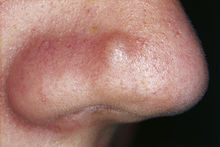- Fibröse Nasenpapel
-
Klassifikation nach ICD-10 D23.3 Sonstige gutartige Neubildungen: Haut sonstiger und nicht näher bezeichneter Teile des Gesichtes ICD-10 online (WHO-Version 2011) Eine fibröse Nasenpapel (engl. fibrous papule of the nose; ICD-O 8724/0) ist eine gutartige Gewebeneubildung (Neoplasie), die sich typischerweise an der Nasenspitze oder an einem Nasenflügel bildet. Seltener sind Lokalisationen der fibrösen Papel außerhalb des Nasengebietes. In solchen Fällen spricht man von einer fibrösen Gesichtspapel.
Inhaltsverzeichnis
Beschreibung und Diagnose
Bei der fibrösen Nasenpapel handelt es sich um einen Hamartom (eine gutartige tumorartige Gewebe-Fehlbildung),[1] die üblicherweise bevorzugt bei Erwachsenen, unabhängig vom Alter, auftritt. Es sind aber auch Fälle bei Kindern ab vier Jahren beschrieben.[1] Die Größe der festen und scharf begrenzten Papel (Knötchen) variiert üblicherweise zwischen 1 bis 5 mm im Durchmesser. Sie ist hautfarben bis leicht rötlich und an der Oberfläche glatt. Fibröse Nasenpapel bilden sich im Wesentlichen am Nasenflügel, an der Nasenflügelfurche oder an der Nasenspitze und sind symptomlos. Sie treten einzel (solitär) auf und bleiben stationär. Auch die Größe kann über viele Jahre konstant bleiben.[2]
Der fibrinstabilisierende Faktor XIIIa, ein Blutgerinnungsfaktor, spielt bei der Bildung einer fibrösen Nasenpapel eine wichtige Rolle. Man geht davon aus, dass eine fibröse Nasenpapel eine Variante eines Angiofibroms ist, das durch dermale Dendrozyten verursacht wird. Diese Zellen sind Faktor-XIIIa-positiv.[3] Gelegentlich enthalten sie auch multinukläre Riesenzellen.[1] Histopathologisch kann die fibröse Nasenpapel in verschiedene Varianten unterteilt werden. So gibt es klarzellige fibröse,[4][5] entzündlich-fibröse, epitheloid-fibröse,[6] pigmentierte fibröse und pleiomorph-fibröse Varianten.[7][8]
Unter Umständen kann zur Abgrenzung eines Basalioms eine Biopsie notwendig sein.[8]
Therapie
Fibröse Nasenpapel können durch eine Flachexzision chirurgisch herausgeschnitten werden. Dabei wird mit einem tangentialen Schnitt die Papule in Höhe der papillären Dermis abgetragen.[9] Eine Alternative ist die Entfernung mit einem Kohlendioxidlaser.[1]
Weiterführende Literatur
- Y. Y. Chiang, H. H. Tsai, W. R. Lee, K. H. Wang: Clear cell fibrous papule: report of a case mimicking a balloon cell nevus. In: Journal of cutaneous pathology Band 36, Nummer 3, März 2009, S. 381–384, ISSN 1600-0560. doi:10.1111/j.1600-0560.2008.01038.x. PMID 19220636.
- W. K. Jacyk, A. Rütten, L. Requena: Fibrous papule of the face with granular cells. In: Dermatology (Basel, Switzerland) Band 216, Nummer 1, 2008, S. 56–59, ISSN 1421-9832. doi:10.1159/000109359. PMID 18032900.
- W. D. Tope, O. P. Sangueza: Rhinophyma's fibrous variant. Histopathology and immunohistochemistry. In: The American Journal of dermatopathology Band 16, Nummer 3, Juni 1994, S. 307–310, ISSN 0193-1091. PMID 7943640.
- W. N. Meigel, A. B. Ackerman: Fibrous papule of the face. In: The American Journal of dermatopathology Band 1, Nummer 4, 1979, S. 329–340, ISSN 0193-1091. PMID 396811. (Review).
Einzelnachweise
- ↑ a b c d H. Traupe, H. Hamm: Pädiatrische Dermatologie. 2. Auflage, Verlag Springer, 2006, ISBN 3-540-25646-6, Eingeschränkte Vorschau in der Google Buchsuche
- ↑ P. Altmeyer: Dermatologische Differenzialdiagnose -- Der Weg zur klinischen Diagnose. Verlag Springer, 2007, ISBN 3540390014, S. 183. Eingeschränkte Vorschau in der Google Buchsuche
- ↑ A. J. Nemeth, N. S. Penneys, H. B. Bernstein: Fibrous papule: a tumor of fibrohistiocytic cells that contain factor XIIIa. In: Journal of the American Academy of Dermatology Band 19, Nummer 6, Dezember 1988, S. 1102–1106, ISSN 0190-9622. PMID 2904927.
- ↑ H. S. Park, S. Cho, K. H. Kim, C. H. Won: Fibrous papule of the face, clear cell type: a case report. In: Journal of the European Academy of Dermatology and Venereology : JEADV Band 21, Nummer 9, Oktober 2007, S. 1267–1268, ISSN 0926-9959. doi:10.1111/j.1468-3083.2007.02160.x. PMID 17894726.
- ↑ A. N. Lee, S. L. Stein, L. M. Cohen: Clear cell fibrous papule with NKI/C3 expression: clinical and histologic features in six cases. In: The American Journal of dermatopathology Band 27, Nummer 4, August 2005, S. 296–300, ISSN 0193-1091. PMID 16121048.
- ↑ C. Kucher, J. M. McNiff: Epithelioid fibrous papule - a new variant. In: Journal of cutaneous pathology Band 34, Nummer 7, Juli 2007, S. 571–575, ISSN 0303-6987. doi:10.1111/j.1600-0560.2006.00667.x. PMID 17576337.
- ↑ C. Bansal, D. Stewart, A. Li, C. J. Cockerell: Histologic variants of fibrous papule. In: Journal of cutaneous pathology Band 32, Nummer 6, Juli 2005, S. 424–428, ISSN 0303-6987. doi:10.1111/j.0303-6987.2005.00362.x. PMID 15953376.
- ↑ a b M. Sand, D. Sand, C. Thrandorf, V. Paech, P. Altmeyer, F. G. Bechara: Cutaneous lesions of the nose. In: Head & face medicine Band 6, 2010, S. 7, ISSN 1746-160X. doi:10.1186/1746-160X-6-7. PMID 20525327. PMC 290354. (Review im Open Access).
- ↑ C. E. Orfanos, C. Garbe: Therapie der Hautkrankheiten. Verlag Springer, 2002, ISBN 3-540-41366-9, S. 923. Eingeschränkte Vorschau in der Google Buchsuche
Wikimedia Foundation.

